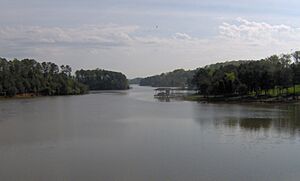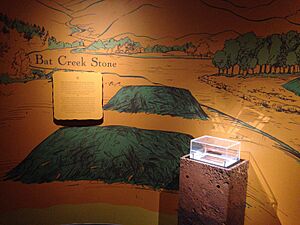Bat Creek inscription facts for kids
The Bat Creek inscription (also called the Bat Creek stone or Bat Creek tablet) is a stone with strange symbols carved into it. It was found in 1889 in a Native American burial mound in Loudon County, Tennessee. This discovery was made by a team from the Smithsonian Bureau of Ethnology, led by Cyrus Thomas.
At first, people thought the symbols were from the Cherokee alphabet, a writing system created by Sequoyah. But in 1970, a scholar named Cyrus H. Gordon suggested the symbols looked like Paleo-Hebrew writing from about 1st or 2nd century AD. This idea made the stone very famous because it would mean people from the Middle East might have visited America long before Christopher Columbus.
However, in 2004, researchers Mary L. Kwas and Robert Mainfort found something important. They discovered that the symbols on the stone were very similar to an image in an 1870 Freemason book. This image showed how a Biblical phrase would look in Paleo-Hebrew. Because of this, experts like Kenneth Feder now believe the Bat Creek inscription is a fake. Mainfort and Kwas themselves clearly stated, "The Bat Creek stone is a fraud."
Contents
What is the Bat Creek Inscription?
The Bat Creek inscription is a small stone, about 11.4 centimeters (4.5 inches) long and 5.1 centimeters (2 inches) wide. It's made of a type of rock called "ferruginous siltstone." It has at least eight symbols carved into it. Seven symbols are in a line, and one is below them.
A Mysterious Discovery
The stone was found during an archaeological dig in 1889. The dig was part of a big project by the Smithsonian Institution to study ancient mounds in America. John W. Emmert, who worked for the Smithsonian, was in charge of the excavation where the stone was found.
Emmert reported that he found the stone under the skull of a skeleton in one of the mounds. Along with the stone, he found two metal bracelets and pieces of polished wood. Later, in 1970, tests showed the bracelets were made of brass, not copper as first thought. In 1988, scientists used radiocarbon dating on the wood pieces. They found the wood was from between 32 AD and 769 AD.
What Do the Symbols Mean?
When the stone was first found, Cyrus Thomas, the head of the Smithsonian's mound survey, thought the symbols were from the Cherokee alphabet. He was sure about it.
But in the 1970s, Cyrus H. Gordon, a scholar who studied ancient languages, looked at the stone again. He said the symbols looked like Paleo-Hebrew, an old form of Hebrew writing. Gordon believed five of the eight symbols could spell "for Judea." This idea was exciting because it suggested that people from ancient Judea (a region in the Middle East) might have traveled to North America long before Europeans arrived.
However, other experts disagreed. Archaeologist Marshall McKusick thought the symbols were still a closer match to Cherokee, even with some difficulties.
The Truth Comes Out
In 1988, an economist named J. Huston McCulloch compared the symbols to both Paleo-Hebrew and Cherokee. He thought they looked more like Paleo-Hebrew. He also pointed out that the radiocarbon date of the wood found with the stone matched Gordon's idea of the stone being from the 1st or 2nd century AD.
But in 1991, archaeologists Robert Mainfort and Mary Kwas, after talking to another language expert, said the inscription was not real Paleo-Hebrew. They believed it was a fake from the 1800s. They thought John W. Emmert, the person who found the stone, was likely the one who faked it.
Later, in 1993, another language expert, P. Kyle McCarter, Jr., agreed that the inscription was not truly ancient Paleo-Hebrew. But he also said it looked like it was trying to copy Paleo-Hebrew and had "an intelligible sequence of five letters." He concluded it was probably a fraud.
The biggest breakthrough came in 2004. Mainfort and Kwas found an old book from 1870 used by Freemasons. This book had a picture showing how the Biblical phrase "holy to Yahweh" would look in Paleo-Hebrew. The symbols in this picture were almost exactly the same as those on the Bat Creek stone!
This discovery strongly suggested that Emmert copied the symbols from the Masonic book. He might have done this to impress Cyrus Thomas, who was looking for artifacts that looked like Cherokee writing.
Where Was it Found?

The Bat Creek stone was found near Bat Creek, which flows into the Little Tennessee River in eastern Tennessee. This area is now partly covered by Tellico Lake, which was created by the Tellico Dam in 1979.
Digging Up the Past
In the 1880s, the Smithsonian Institution sent teams to dig up ancient sites in the Little Tennessee Valley. They found many artifacts and burial sites from Native American groups, including the Overhill Cherokee and even older prehistoric people.
Later, in the 1960s and 1970s, before the Tellico Dam was built, the University of Tennessee also did many archaeological digs in the valley. They found evidence that people had lived there for thousands of years, going back to the Archaic period (8000–1000 BC).
The Bat Creek site itself had three mounds. The stone was found in Mound 3. While many digs happened in the area, no other discoveries ever suggested that people from ancient Old World civilizations had visited the Americas before Columbus.
Where is the Stone Now?
The Bat Creek Stone is still owned by the Smithsonian Institution. It is part of the collections at the National Museum of Natural History in Washington, D.C.
For a while, it was on loan to a museum at the University of Tennessee. Since 2015, it has been on display at the Museum of the Cherokee Indian in Cherokee, North Carolina.
Images for kids




